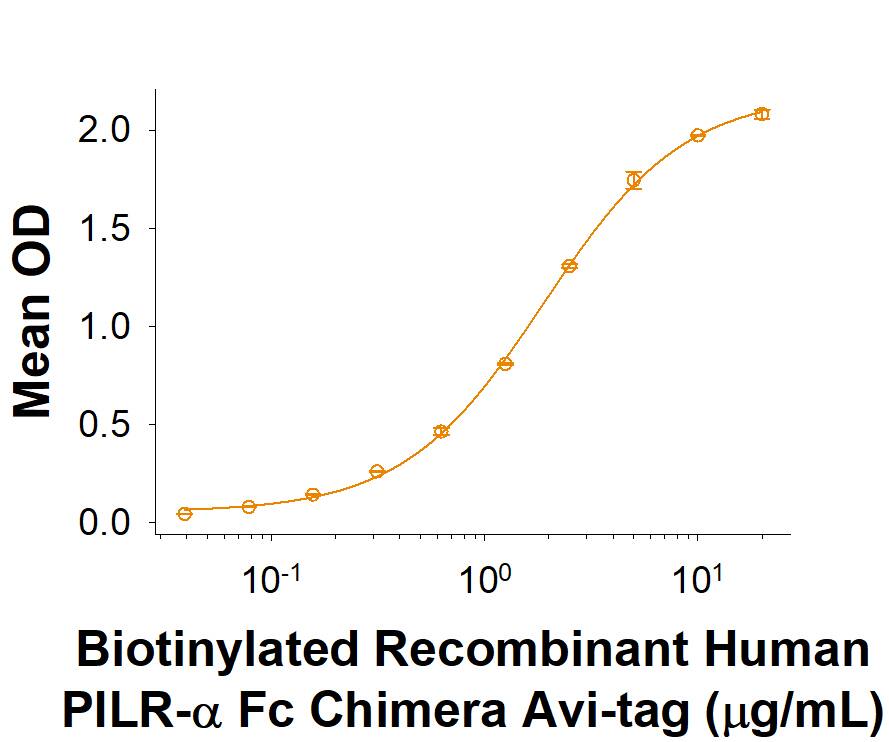Recombinant Human PILR-alpha Fc Chimera Avi-tag Protein, CF
R&D Systems, part of Bio-Techne | Catalog # AVI10702
Biotinylated

Key Product Details
Learn more about Avi-tag Biotinylated Proteins
Source
CHO
Accession #
Structure / Form
Disulfide-linked homodimer, biotinylated via Avi-tag
Conjugate
Biotin
Applications
Bioactivity
Product Specifications
Source
Chinese Hamster Ovary cell line, CHO-derived human PILR-alpha protein
| Human PILR-alpha (Gln20-Thr196) Accession # Q9UKJ1.3 |
IEGRMD | Human IgG1 (Pro100-Lys330) |
Avi-tag |
| N-terminus | C-terminus | ||
Purity
>90%, by SDS-PAGE visualized with Silver Staining and quantitative densitometry by Coomassie® Blue Staining.
Endotoxin Level
<0.10 EU per 1 μg of the protein by the LAL method.
N-terminal Sequence Analysis
Thr25
Predicted Molecular Mass
48 kDa
SDS-PAGE
60-70 kDa, under reducing conditions
Activity
The biotin to protein ratio is greater than 0.7 as determined by the HABA assay.
Measured by its binding ability in a functional ELISA.
When Recombinant Human PANP Fc Chimera (Catalog # 7920-PN) is coated at 5 μg/mL, 100 μL/well, Biotinylated Recombinant Human PILR‑ alpha Fc Chimera Avi-tag (Catalog # AVI10702) binds with an ED50 of 0.6-6 μg/mL.
Measured by its binding ability in a functional ELISA.
When Recombinant Human PANP Fc Chimera (Catalog # 7920-PN) is coated at 5 μg/mL, 100 μL/well, Biotinylated Recombinant Human PILR‑ alpha Fc Chimera Avi-tag (Catalog # AVI10702) binds with an ED50 of 0.6-6 μg/mL.
Scientific Data Images for Recombinant Human PILR-alpha Fc Chimera Avi-tag Protein, CF
Recombinant Human PILR-alpha Fc Chimera Avi-tag Protein Binding Activity.
When Recombinant Human PANP Fc Chimera (7920-PN) is coated at 5 μg/mL, 100 uL/well, Biotinylated Recombinant Human PILR‑ alpha Fc Chimera Avi-tag (Catalog # AVI10702) binds with an ED50 of 0.6-6 μg/mL.Formulation, Preparation and Storage
AVI10702
| Formulation | Supplied as a 0.2 μm filtered solution in PBS. |
| Shipping | The product is shipped with dry ice or equivalent. Upon receipt, store it immediately at the temperature recommended below. |
| Stability & Storage | Use a manual defrost freezer and avoid repeated freeze-thaw cycles.
|
Background: PILR-alpha
References
- Wilson, M.D. et al. (2006) Physiol. Genomics 27:201.
- Lanier, L.L. (2001) Curr. Opin. Immunol. 13:326.
- Fournier, N. et al. (2000) J. Immunol. 165:1197.
- Shiratori, I. et al. (2004) J. Exp. Med. 199:525.
- Mousseau, D.D. et al. (2000) J. Biol. Chem. 275:4467.
- SwissProt Accession # Q9UKJ1.
- Tato, C.M. et al. (2012) PLoS ONE 7:e31680.
- Satoh, T. et al. (2008) Cell 132:935.
- Tabata, S. et al. (2008),J. Biol. Chem. 283:8893.
- Sun, Y. et al. (2012) J. Biol. Chem. 287:15837.
- Wang, J. et al. (2008) J. Biol. Chem. 180:1686.
- Arii, J. et al. (2010) J. Virol. 84:10733.
- Karch, CM. et al. (2016) PLoS ONE. 11:1-22.
- Allen, M. et al. (2015) Neurol Genet. 1:e15 (PubMed: 27066552).
- Patel, T. et al. (2018) Neurolpathol Appl Neurobiol. 44(5):506-521.
- Rathore, N. et al. (2018) PLoS Genet. 14(11):e1007427.
Long Name
Paired-Ig-likeType 2 Receptor alpha
Alternate Names
FDF03, PILRA, PILRalpha
Gene Symbol
PILRA
UniProt
Additional PILR-alpha Products
Product Documents for Recombinant Human PILR-alpha Fc Chimera Avi-tag Protein, CF
Product Specific Notices for Recombinant Human PILR-alpha Fc Chimera Avi-tag Protein, CF
For research use only
